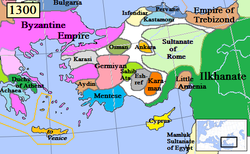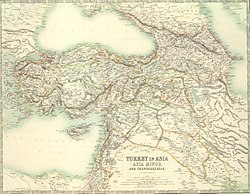Germiyan | |||||||||
|---|---|---|---|---|---|---|---|---|---|
| 1300–1429 | |||||||||
 Beylik of Germiyan (light red) in 1300. | |||||||||
| Capital | Kütahya | ||||||||
| Common languages | Old Anatolian Turkish | ||||||||
| Religion | Muslim | ||||||||
| Government | Monarchy | ||||||||
| Bey | |||||||||
• 1300–1340 | Yakub I | ||||||||
• 1340–1361 | Mehmed | ||||||||
• 1361–1387 | Suleiman | ||||||||
• 1387–1429 | Yakub II | ||||||||
| Historical era | Late Medieval | ||||||||
• Established | 1300 | ||||||||
• Disestablished | 1429 | ||||||||
| |||||||||
| History of Turkey |
|---|
 |
| Timeline |
|
|
The Germiyanids (Old Anatolian Turkish: كرميان; Turkish: Germiyanoğulları Beyliği or Germiyan Beyliği) were a prominent Anatolian beylik established by the Oghuz Turkish tribes[1] (probably the Afshar tribe)[2] after the decline of the Sultanate of Rûm. While the beylik was always mentioned as being ethnically Turkoman or Oghuz Turkish, the population consisted of Turks and Yezidi Kurds, brought by the Seljuks from the east of Malatya to western Anatolia as militia guards against the threatening Turkish tribesmen.[3][4][5][6][7]
- ^ İnalcık, Halil (1993). The Middle East and the Balkans under the Ottoman Empire : essays on economy and society. Bloomington: Indiana University Turkish Studies. p. 97. ISBN 9781878318046.
- ^ Leiser, Gary; Koprulu, Fuat (1992). Origins of the Ottoman Empire. p. 37. ISBN 9781438410432.
- ^ Ducas, Harry J. Magoulias, Ducas, 1975 , Decline and fall of Byzantium to the Ottoman Turks, p. 265, Wayne State University Press, University of Virginia ISBN 0-8143-1540-2, ISBN 978-0-8143-1540-8, The Germiyan were probably Kurdish and Turkish half-breeds who came from east of Malatya.
- ^ Peter Malcolm Holt, 1986, The Age of the Crusades: the Near East from the eleventh century to 1517, p. 176, Longman, University of Michigan, ISBN 0-582-49303-X, 9780582493032 The second of the eastern principalities, Germiyan, developed from a group, probably of mixed Kurdish and Turkish origin
- ^ Marios Philippides, Biblioteca apostolica vaticana - 1990, Byzantium, Europe, and the early Ottoman sultans, 1373-1513: an anonymous Greek chronicle of the seventeenth century, p. 6, A.D. Caratzas, University of Michigan, ISBN 0-89241-430-8, ISBN 978-0-89241-430-7, Near Byzantine borders in Phrygia, the emirate of Germiyan was formed by a mixed population of Turks and Kurds, who had come from east of Malatya
- ^ Carl F. Petry, 1998, The Cambridge History of Egypt, Vol. 1, p. 527, Cambridge University Press ISBN 0-521-63313-3, ISBN 978-0-521-63313-0, An Anatolian Turco-Kurdish dynasty, with its capital at Kutahya
- ^ Bruinessen, Martin van (1992). Agha, Shaikh and State: The Social and Political Structures of Kurdistan. Bloomsbury Academic. p. 161. ISBN 978-1-85649-018-4.